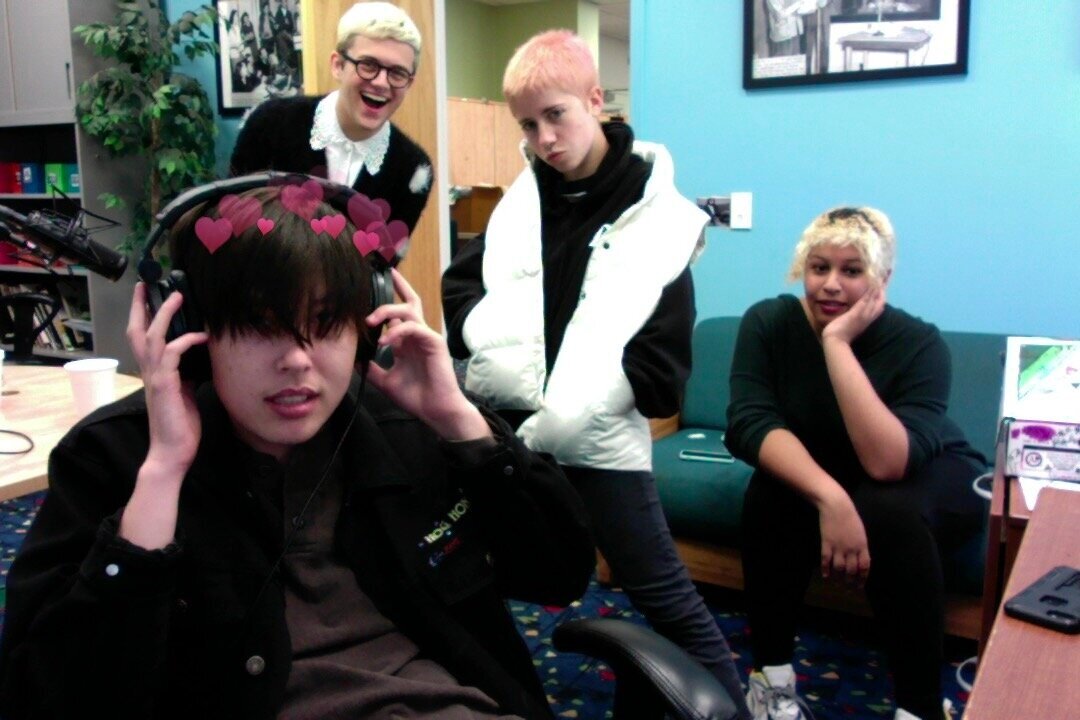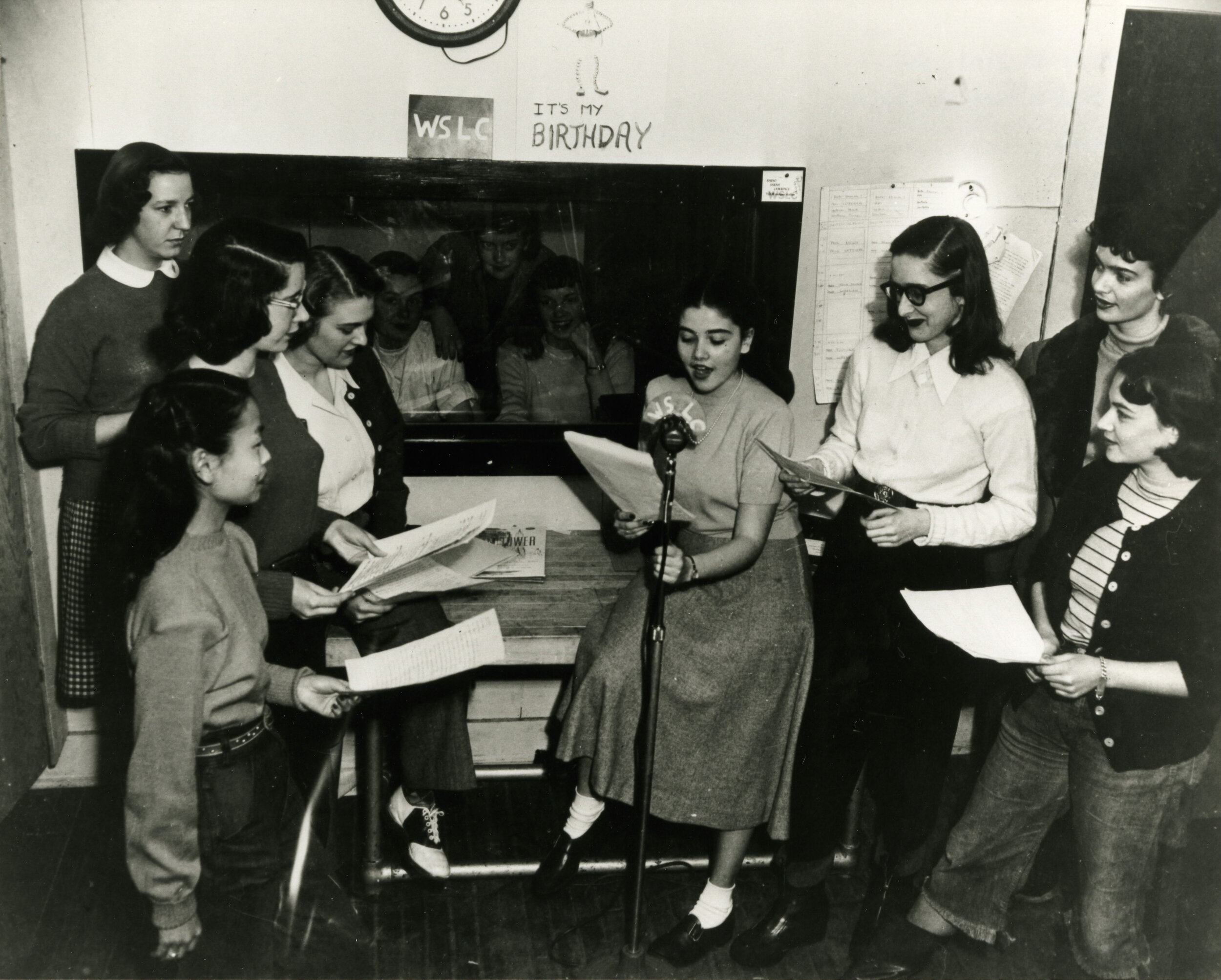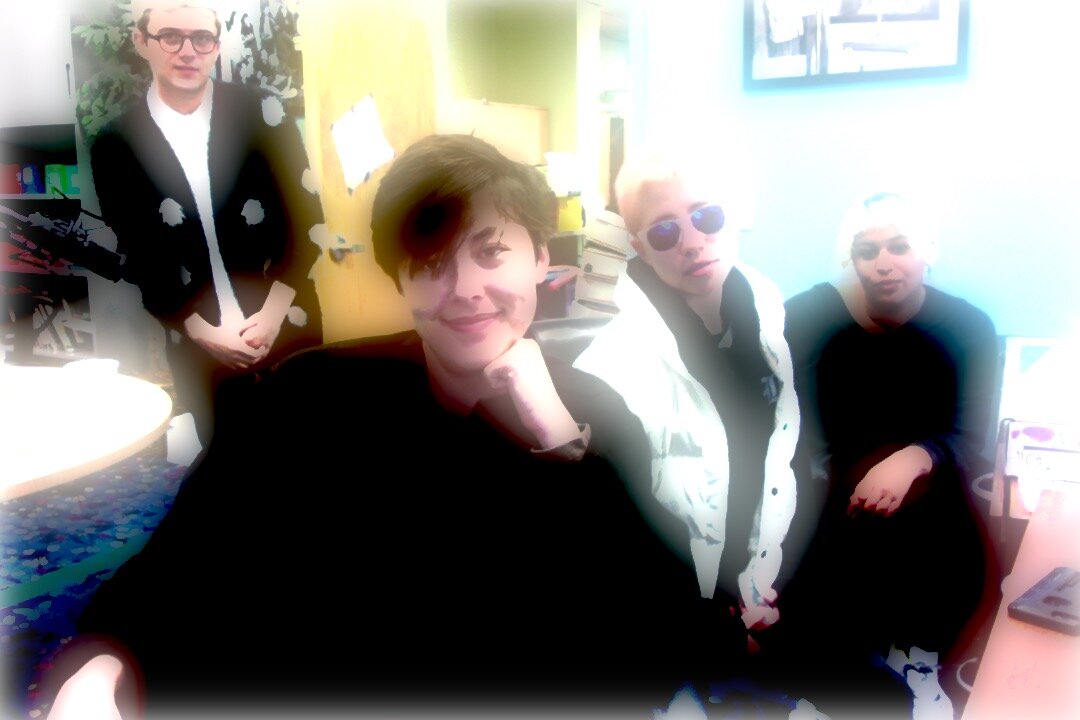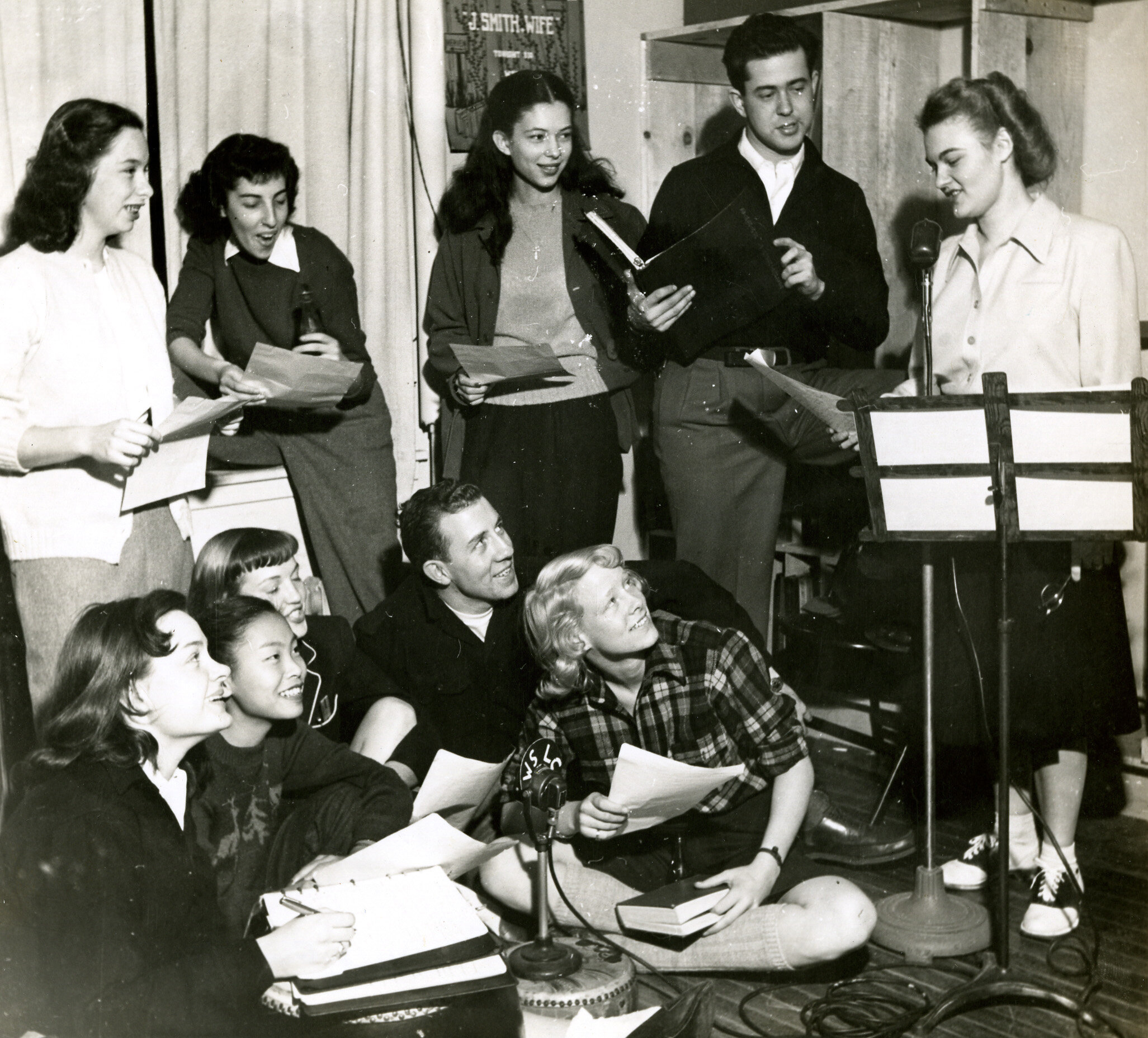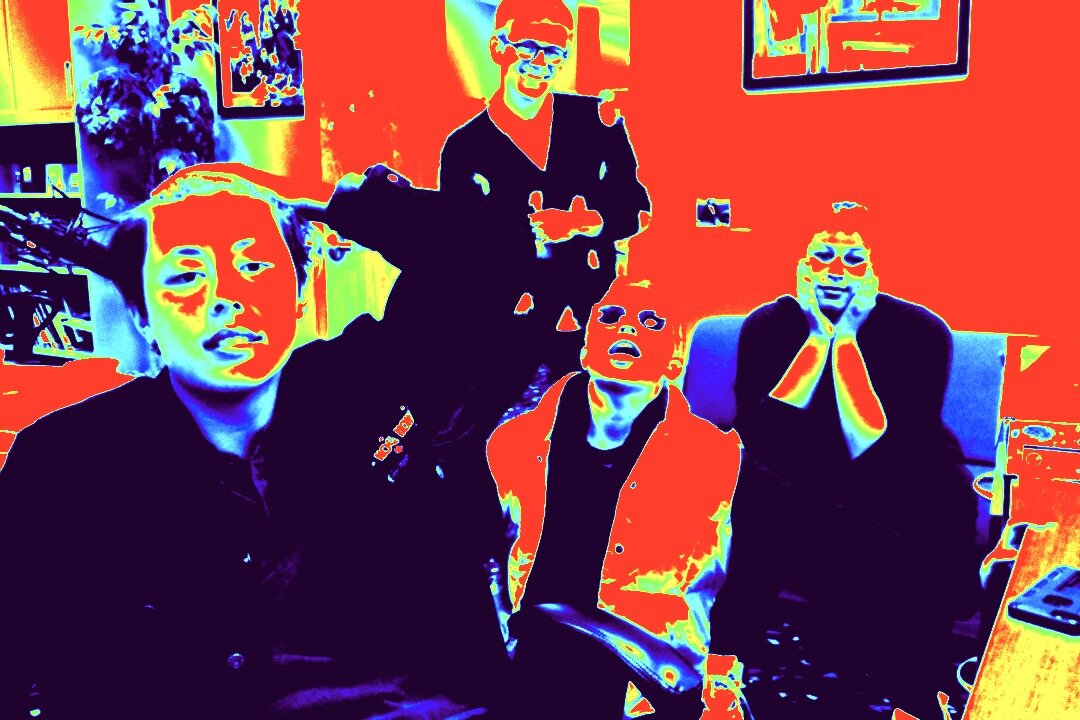WSLC is About More Than Just Streaming This Year
One of the first things you notice when you enter the WSLC broadcast room is a wall plastered with colorful drawings, photos, and sketches promoting past shows and events, and to its right, a whiteboard which cautions DJs against covering up holes in the wall with art.
“That’s a rule because someone had literally punched a hole in the wall when we took over the job,” General Manager Kate Chaloemtiarana ‘20 explains.
In typical Sarah Lawrence fashion, WSLC deviates from a traditional college radio station in many ways, but primarily by not broadcasting on AM/FM radio waves. For the last decade and a half, WSLC has been an internet-only radio station.
Its broadcast room on the second floor of Bates is filled with artifacts from previous eras and recent additions that show how the station has grown. A box of crayons, markers, and a stack of blank paper is kept near the recording equipment, and DJ’s are encouraged to doodle during their shows. One wall is decorated with large black and white pictures of cheerful Sarah Lawrence students broadcasting in a professional-looking recording booth dating back to the 1940’s and 50’s, and a shelf in the back corner contains stacks of CDs and LPs that used to serve as the station library.
WSLC—then known as ‘Radio Sarah Lawrence’—had its first broadcast on 105.7 FM in February of 1946, then only for “two nights and an hour every morning during the week,” according to the yearbook. In its first few decades, the station hosted more academic programs, briefly airing performances by drama classes, theater troupes, student ensembles, as well as educational lectures and discussions on music history between distinguished professors.
For decades after, college radio DJs were required to keep scrupulous lists of the songs and artists that were played on their shows. Then, WSLC’s music manager sent these lists to the College Music Journal, a monthly music magazine that published statistics and charts of who or what was gaining traction on collegiate airwaves. A spot on a CMJ list was a big deal for up-and-coming artists. It wasn’t exactly the Billboard Hot 100, but it meant you were cool, or at least well-known among tastemaking college students. In a tragic event for backpack rappers and shoegaze artists everywhere, the College Music Journal ceased publication last year, and WSLC is no longer governed by a higher regulatory body.
There are certain benefits to switching to Internet radio, though. Traditional radio means broadcasting consistently, twenty-four hours a day, and only certain songs can be played.
“Sarah Lawrence has never really had a wide enough listening base to keep that up,” says Chaloemtiarana. Currently, WSLC broadcasts forty-five shows a week, from 4pm to 1am, Mondays through Fridays, hosted online by Live365 Internet radio. The platform’s standards for what can be played are much more lax, offering students the chance to experiment with unique and diverse show formats. They are no longer limited by Federal Communications Commission regulations, meaning they can play brand-new, rarely-heard songs by up-and-coming artists from music sharing sites like Soundcloud or Bandcamp, or even music created by themselves and their peers.
There are some rules, however. Chaloemtiarana and SD Diamond, ‘20, the station’s Operations Manager, maintain a “Banned Bands” list, which currently consists of OneRepublic, Imagine Dragons, and The Fray. Although the list is obviously a joke at the expense of some bands they don’t like, there’s a reason they keep it up.
“The station as we knew it, when me and SD started, was basically ‘cis white dudes of Sarah Lawrence’, and that was who the DJ base was.” explains Chaloemtiarana. Now, for the first time ever, all four managers are non-binary. To them, the banned bands are a representation of the station’s past, and of the “indie-rock bros” that used to manage it, although Chaloemtiarana admits the biggest reason they still keep a banned bands list is just because it’s funny.
“I don't even really have a real answer for why we do it,” says Chaloemitiarana. “[When we started], there wasn't anything kind of funny about this station. And we want it to be whimsical.”
Attempts at whimsy also include the creation of a “station voice,” a persona assumed by Diamond in their e-mails to the DJ staff. The station, which introduces itself as “I, the radio station,” will welcome DJ’s to “be inside of me,” or “make sure to clean me when you’re done using me.”
Despite all the shenanigans (or perhaps because of it), Chaloemtiarana sees the radio less as a job and more as a creative outlet.
“You don't need any background experience,” Chaloemtiarana says. “You can be from any club or walk of life that Sarah Lawrence has, and like, just have a playlist. Everyone can make a playlist. I think that's what draws people to it. There's this weird sense of community, but also you have so much freedom within that community.”
WSLC shows tend to fall into two categories. The first is the classic college radio stereotype — loosely structured playlists of new and interesting music with occasional commentary and analysis, and the second — shows that are more structured and consistent with their programming.
One example of that second style is “Amateur Galaxy,” hosted by Katie Duke ‘20, which airs at 11pm on Mondays. According to Duke, “Amateur Galaxy” will play a mixture of new wave, and post-punk music, punctuated by frequent guest appearances from friends. True to her show’s name, Duke, or “DJ Stepmom,” plans to adopt a “cosmic motif” in the show’s branding and talking segments.
Kate Sabiston, ‘23, hosts a show called “Burnt Out,” Mondays at 7pm, which is based on a playlist she made last year for a friend who was having trouble finding new music.
“It's essentially a show for those who want to listen to music but don't know what they want to listen to,” said Sabiston. “The music is very decompressing, and it acts as a ‘reset button’ for when you're in a weird headspace and need your music to match that energy,” she says.
Sabiston draws inspiration from artists like Beach House, Kendrick Lamar, and the National, mostly sticking to indie and alternative hip-hop, although she’ll play anything that fits her required vibe of “dark, chilling, and oddly relaxing.”
But music shows are not all WSLC has to offer. There are also a number of high-concept shows designed by DJs eager to take full advantage of the freedom offered to them by Internet radio.
One show the managers are excited about this year is “The Golden Hour,” which airs at 4pm on Fridays. Hosted by Morgan Lui ’22, and Sarah Adams ‘23, the show will enlist student actors every week to re-enact radio dramas of the 1930’s and 40’s, complete with era-appropriate music and vintage commercial breaks.
Fridays at 11pm is the “Manager Hour”, hosted by the WSLC staff, where the managers plan on highlighting some of their favorite shows of the week and playing mixtapes they find lying around the station.
“Girls to The Front,” hosted by Margaret McGuinness '23, is an hour dedicated to showcasing the best of the feminist punk riot grrl movement, and airs Mondays at 8pm.
Jessie Moore, '23, will be hosting a show called "Hometown Hits" Thursdays at 9pm. Each episode will feature a guest host and focus on the music that reminds them of their hometown.
Rounding out the talk show lineup is “Big Girl Business,” a financial advice and economic talk show hosted by Antonia Knox ‘21 and Nell Sanders ‘21, Tuesdays at 5pm.
WSLC’s new logo, designed by Community Manager, Sam Kurzydlo, ‘21
Along with a slate of brand new shows, WSLC is also debuting a brand new logo, designed by Community Manager Sam Kurzydlo, ‘21. Taking inspiration from the station’s well-worn geometric neon carpet design, the managers hope that the new logo will usher in a new era and personality for WSLC.
“We all decided that it was time for something other than black letters on a little background … It's a new logo that reflects a new attitude about the station, while still having a firm connection to what it's always been,” Kurzydlo said, adding that they hoped the logo would bring out the natural character of the space and the people who use it every day.
Sarah Lawrence student DJs come from different friend groups, different years, and are often interested in varying genres and styles of music, united only by their love of the job. But when DJs only come by the station for one hour a week, they aren’t interacting as much as they could be.
This year, building solidarity between DJ’s will be as much of a focus as attracting them used to be. “There isn’t really that sense of community,” Chaloemtiarana says. “A really big focus for us for the past couple of years has been actually trying to get WSLC to be representative of how we see Sarah Lawrence at its best,” Chaloemtiarana adds, citing the new identity group radio hour as one example of that.
Identity based groups such as QPOC, Queer People of Color; Kula, a student-run organization for Asian, Pacific Islander, and Desi-identifying students; Harambee, a student union representing students who identify as part of the African Diaspora; and Unidad, a community for Latinx students, will take turns hosting a weekly radio show.
“Every Monday at ten, it’ll be a different group presenting on something fun that they feel is relevant to their club,” Chaloemtiarana says. “I introduced that last year because I felt like the DJs were a largely white audience and group of people. We’ve been really trying to focus on getting a more diverse range of shows and people.”
Chaloemtiarana says that they believe that college radio should be a part of the college experience, even as the definition of college radio itself changes rapidly.
“People still like it, but people don’t necessarily listen to the radio that much,” they explained. Planning and recording shows is “more fun for the DJs,” whereas WSLC’s live music events “are more for the community.”
At the end of last year, the Sarah Lawrence Student Life Activities Council Live Music department was dissolved, leaving WSLC responsible for bringing all live music to campus.
Last month, WSLC hosted a triple-header featuring New York artists Jimi Lucid, Navy Gangs, and Noble Spell. Lakota Harvey, ‘21, WSLC’s Music Manager, is currently in the process of finding and planning the next show, scheduled for October 25th.
“I remember hearing that the year before we got here, Porches came to play Springfest. And then also Mac DeMarco,” Diamond explained. “We're not trying to book those kinds of people right now. Because they're just like, grimy dudes.” As a counterpoint, Diamond mentioned last year’s Spring Fest, WSLC’s annual spring music festival, featured “all queer people, which is awesome. And a good mix of genres, too. In terms of booking bands, like, we do try and book queer or POC bands.”
Diamond was quick to clarify that they still enjoy Porches and Mac DeMarco, but wanted the WSLC live music series to avoid established musicians that students on campus are likely to be familiar with.
“We were like, oh, we have a position where we're in New York, we have access to Student Senate funding, and we could really get exposure for bands who want to play for cool people and aren't really huge names,” says Chaloemtiarana. “If you want to go see the people that you associate with ‘college culture’, you can go to Brooklyn. We're just trying to bring faces and voices to campus that makes somebody go, oh, I hadn't heard that before.”
“We try to get a lot of DIY bands,” Harvey said, adding that they usually contact artists through social media. Sometimes touring artists come to Sarah Lawrence for an intimate warm-up show a few days before a big performance in New York, or Harvey approaches New York-based artists eager to build a local fanbase.
After first approaching an artist, “we figure out what's going on and then see if they're available,” says Harvey. “Then we send them contracts.” The process is much quicker and simpler than one would expect, and often Harvey deals directly with the artists themselves, not an intermediary like an agent or manager.
Unless performers bring their own sound engineer, Diamond and Chaloemtiarana handle the technology and gear setup for the live shows, and Harvey handles the ‘hospitality’ aspect, which can involve finding a green room, making sure the artists are comfortable and ready to perform, and more often than not, showing them where to buy beer.
“It's really important to us that the artists feel appreciated for coming out to Westchester,” said Chaloemtiarana. “And when people come to the shows, they really do.”
Most artists stick around after their sets to hang out with students, and often exchange contact information and keep in touch over social media.
Most shows will be located in the new Barbara Walters Campus Center, but the managers are also looking at hosting gigs on other spaces on campus, like the Performing Arts Center, Blue Room, and Bates Basement. The Barbara Walters performance space was designed for live performances, which made for great acoustics at WSLC’s first show of the year. But for many, a problem is that the space is actually too hospitable.
“It does take away kind of like the previous vibe that we had, which was kind of grungy and kind of like DIY in the Blue Room,” Diamond says, referring to previous years’ performance space, the now-shuttered but endearingly cramped and dingy basement. “We're trying to work out like how we can maneuver that, because sometimes you want it to sound good rather than just be aesthetically gross.”
Diamond emphasizes the managers’ commitment to using live music as an opportunity to revive Sarah Lawrence’s dormant DIY scene this year.
“I feel like it used to be something before we were all here and now it’s not really a thing,” says Diamond, whose job as Operations Manager entails fixing and maintaining all the technology and recording equipment owned by WSLC. “There’s not a lot of on campus bands,” they added, though that soon may change. WSLC recently purchased a drum set and some amplifiers, usually the two heavier and more expensive types of equipment that prevent amateur bands from performing on a whim.
“I want the student musicians here to feel like they have a specific outlet to share their talent with us,” said Kurzydlo, who has been planning on participating in a college radio station since they were in high school. As Community Manager, their main responsibilities include communicating with DJs, ensuring community standards are met, and promoting shows and live performances on social media. Social media wasn’t always part of the job description, but now it encompasses a large swath of Kurzydlo’s time.
“As the years have gone on, we've sort of influenced the job description,” they say. “I think that I've made the community manager job more about promotion than it was before. For a while, our Facebook and Instagram were followed by a lot of alumni, and I've really taken it upon myself to make sure that we're reaching current students as well.”
This year’s WSLC managers are acutely aware that their tenure comes at a time in Sarah Lawrence history where the campus is changing as fast as the radio station.
“Something that I know is important to all four managers is that there's so much passion and creativity that this student body has to showcase, and we want to make sure that the wider campus community knows that this is the place for it,” Kurzydlo says.
If you tune into Kurzyldo’s own show, “Grandma’s Dusty Attic,” Mondays at midnight, you’ll get to hear a musical grab-bag of artists like Merzbow, Lightning Bolt, Ariana Grande, and Steve Reich, but more importantly, Kurzydlo fully taking advantage of the freedom Internet radio provides.
When asked what their favorite part of streaming on the internet instead of traditional radio was, Kurzydlo remained honest.
“You can swear as many times as you want!”
Steve Orlofsky, ‘21

